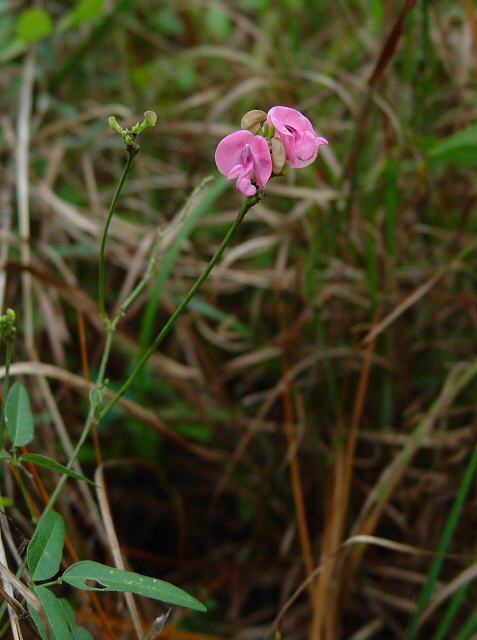Strophostyles umbellata (Muhl. ex Willd.) Britton
Wild Bean

Native
CC = 3
CW = 3
MOC = 41
© DETenaglia
Strophostyles umbellata (Muhl. ex Willd.) BrittonWild Bean | |
 |
Native CC = 3 CW = 3 MOC = 41 |
© DETenaglia |
|
Family - Fabaceae/Faboideae Habit - Taprooted forb, usually perennial, twining in other vegetation. Stems - Vining, twining, to 1.5 m, retrorse pubescent, terete to slightly angled, often twisted, often purplish in strong sunlight. Leaves - Alternate, trifoliate, stipulate, stipellate, petiolate. Stipules spreading, triangular, 2-3mm long, striate-nerved, glabrous to strigose, entire. Petioles 1.5-3.0 cm long, sparse antrorse strigose, with a deep adaxial groove. Stiples on all leaflets ovate-triangular, entire, 1.2 mm long, mostly glabrous. Petiolules of lateral leaflets 1-2 mm long, pubescent adaxially. Petiolule of terminal leaflet 6-7 mm long, pubescent as the petiole. Leaflets rounded or angled at the base, angled or tapered to a rounded or bluntly to less commonly sharply pointed tip, often with a minute extension of the midvein at the very tip, the upper surface glabrous or nearly so, the undersurface sparsely to moderately appressed-hairy; the terminal leaflet with a stalk 4-8 mm long, the blade 1.5-3.5 cm long, 0.8-2.0 cm wide, triangular-lanceolate to lanceolate or narrowly ovate, unlobed; the lateral leaflets sessile or with a stalk to 1.5 mm long, the blade 1.5-3.5 cm long, 0.8-2.0 cm wide, triangular-lanceolate to lanceolate or narrowly ovate, unlobed.
Inflorescence - Axillary solitary flowers or more commonly headlike clusters of 2-5 flowers, the inflorescence stalk 5-20 cm long, the flower stalks 0.5-2.0 mm long, the pair of bractlets closely subtending each flower 1-2 mm long, shorter than the calyx tube.
Flowers - Calyces with the tube 1.5-3.0 mm long, glabrous or nearly so, the lobes 1.0-2.5 mm long. Corollas papilionaceous, pink, usually fading to greenish yellow, the banner 8-13 mm long, the wings 6-10 mm long, the keel 8-10 mm long, white at the base, wine-purple at the apex, the beaklike apical portion relatively stout and only slightly curved or twisted to the side. Stamens diadelphous, the tube white and glabrous, deflexed and connate around the style. Free portions of stamens 5-6 mm long. Anthers yellow, 0.7 mm long. Ovary green, superior, 5-6 mm long in flower, sericeous.
Fruits - Legumes 4-7 cm long, 2.5-5.5 mm wide, sparsely to moderately hairy at maturity, 5-10 seeded. Seeds 3.5-5.5 mm long, the surface sometimes appearing waxy, brown, sometimes faintly mottled, pubescent with whitewoolly patches.
Flowering - June - October. Habitat - Bottomland and mesic forests, streambanks, bases of bluffs, sand prairies, glades, pastures, fields, roadsides, often on acidic substrates. Origin - Native to the U.S. Lookalikes - Strophostyles leiosperma, S. helvola. Vegetatively similar to Amphicarpaea bracteata. Other info. - This species can be found mostly in the southern half of Missouri but it is also present in counties along the Mississippi and Missouri rivers. Beyond Missouri it is found in most of the southeastern quadrant of the continental U.S. There are three species of Strophostyles in Missouri, and the genus is easy to recognize because of the curled and deflexed keel petal of the corolla. Differentiating between the three species requires attention to tiny detail. In S. umbellata, the leaves are unlobed with glabrous upper surfaces, and the bractlets subtending the flower are much shorter than the calyx. Photographs taken at Fort Benning, GA., 10-10-05 (DETenaglia); also at LaBarque Creek Conservation Area, Jefferson County, MO, 8-28-2018 (SRTurner). |